



Presentation on EU-IMF Interest Rates Professor Karl Whelan University College Dublin Presentation to Joint Oireachtas Committee on European Affairs January 25 th 2011
EU-IMF Funding: Four Sources • External funding of € 67.5 billion has been offered: – € 22.5 billion from the IMF. – €22.5 billion from the EU’s European Financial Stability Mechanism (EFSM). – € 17.7 billion from the European Financial Stability. – € 4.8 billion in bilateral loans from the UK, Sweden and Denmark. • I will discuss the cost of the loans from the first three sources.
The IMF Loans: General Terms • Variable interest rate loans with the rate depending on short-term money market rates. • Funds are loaned in SDRs, which is a basket of euros, dollars, sterling and yen. • Loan is from an Extended Fund Facility program and terms are standard across all countries. • Loans up to 300 percent of a country’s quota are at very low interest rates. Larger loans carry a surcharge and this surcharge increases if loans are not repaid after three years.
The IMF Loans: Interest Rate • Ireland’s loan is 23 times its current quota so most of the loan will carry a large surcharge. • Based on Ireland’s current quota and current market interest rates : – The average interest rate during the first three years would be 3.12%. – After the first three years, the interest rate would rise to 3.99%. • But Ireland’s quota is being raised, dropping these rates by 20 basis points: Over 7.5 years, the average margin on this loan over market variable rates is 317 basis points.
IMF Loans: Fixed Rate Equivalent • The IMF loans carry two risks for Ireland – Interest Rate Risk : Short-term interest rates that the IMF variable lending rate is based upon are very likely to rise over the next few years. – Currency Risk : If the euro depreciates relative to the other currencies in the SDR basket, this will effectively raise the cost of the IMF loan. • If the stream of IMF payments were swapped for a loan that had a fixed rate in financial markets, the fixed rate would be about 5.7%.
The EFSM Interest Rate • The EFSM is borrowing € 22.5 billion on behalf of the EU at fixed rates and with an average maturity of 7.5 years. • It is then lending these funds to Ireland with a profit margin of 292.5 basis points. • The NTMA estimated in December that these loans will have an average interest rate of 5.7%. • Based on recent developments in market interest rates and the pricing of EFSM’s first bond, I believe this rate could be close to 6.1%.
EFSF Complex Structure Raises Cost • EFSM borrowing based on financial resources of EU budget: Not sufficient to deal with Euro area sovereign debt crisis. • EFSF set up to allow each Euro area country to guarantee additional funds to be loaned to sovereigns experiencing difficulty. • Not all of the guarantors have high credit ratings. EFSF thus contains a number of features to make it more attractive to investors. • These additional features add to the cost: This funding is likely to cost 35 basis points more than the EFSM.
Example of an EFSF Loan
Comparing IMF and EU Interest Rates • It may appear that the IMF loans carry a lower rate than the corresponding EU loans. • However, it is likely that variable interest rates will rise considerably, so IMF loan rates will increase. • Once IMF loans are compared with the EU loans in terms of the likely overall costs of funding over a long period, their costs appear to be relatively similar. • When compared with the appropriate market costs of funding, the margins added on to determine the cost of funding for Ireland are similar for IMF and EU sources.
Room for Getting a Lower Rate? • IMF loan terms are standardised for every country in the world: There is no room for reducing this element of the cost of the loan. • Margins for EU loans have not been set in stone and have already been changed compared with original plans. • The rate at which the EU is lending money to Ireland is lower than the rates at which the state could raise funds in financial markets. But there are limits to how far this comparison should be pushed. • The EU lending packages are explicitly related to a political goal of European solidarity and the interest rates on these loans should be judged accordingly.
Recommend
More recommend